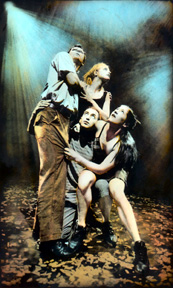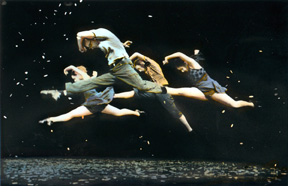If
You Go Down To the Woods Today
Cas Public
New Victory Theater
New York, NY
February 28, 2004
by
Susan Reiter
copyright 2004 by Susan Reiter
published 23 February 2004
 Performances
such as this, which are designed for what's called the "family audience,"
are certainly best evaluated by attending with a child of the appropriate
age. This 45-minute offering by the Montreal-based troupe Cas Public seems
aimed at the eight-and-under set, and I did not have such a companion
along whose reaction to gage. The matinee audience was loaded with kids
who seemed eager and attentive, and laughed at the appropriate places.
From an adult perspective, the piece was heavy on the talk and limited
in its movement interest.
Performances
such as this, which are designed for what's called the "family audience,"
are certainly best evaluated by attending with a child of the appropriate
age. This 45-minute offering by the Montreal-based troupe Cas Public seems
aimed at the eight-and-under set, and I did not have such a companion
along whose reaction to gage. The matinee audience was loaded with kids
who seemed eager and attentive, and laughed at the appropriate places.
From an adult perspective, the piece was heavy on the talk and limited
in its movement interest.
Choreographed by Helene Blackburn, whose bio outlines a 20-year career, If You Go Down to the Woods Today is an unsubtle exploration of the fears that children—and all of us—are prey to. The five dancers present a childlike manner without being cloying (the three men are particularly adept at appearing goofy and sweetly awkward), and they invest the thin material with earnest sincerity and rambunctious energy.
The stage is stripped bare of wings, with the back wall exposed, and a thin layer of small leaves is strewn across it. The dancers introduce themselves to us by announcing what they are afraid of: the dark, monsters under the bed, airplanes, weird noises, monsters under the bed, thunder. The begin to move with rapid, mechanistic unison gestures while remaining in place, before the piece opens up to brief individual sections, mostly set to excerpts from Paganini's 24 Caprices for Violin.
 There
are bursts of athletic, hard-edged dancing, including rough-and tumble
partnering, but the performers never keep quiet for long. Frequently,
one dancer is taunted about his or her particular fear by another. They
are convincing as a group of playmates who share a mutual affection but
also enjoy playing on each others' weaknesses. Their behavior (often stubborn
or sulky) and language were clearly on a level to which the kids in the
audience could relate. As an old fogey, however, I wished that something
more sustained would occasionally emerge. Just when a passage—an
interestingly shaped double duet, for example—would start to show
some choreographic development, it would be time to move on to something
else. Too often, they returned to their face-the-audience unison semaphore-like
sequences accompanied by sing-songy simplistic text.
There
are bursts of athletic, hard-edged dancing, including rough-and tumble
partnering, but the performers never keep quiet for long. Frequently,
one dancer is taunted about his or her particular fear by another. They
are convincing as a group of playmates who share a mutual affection but
also enjoy playing on each others' weaknesses. Their behavior (often stubborn
or sulky) and language were clearly on a level to which the kids in the
audience could relate. As an old fogey, however, I wished that something
more sustained would occasionally emerge. Just when a passage—an
interestingly shaped double duet, for example—would start to show
some choreographic development, it would be time to move on to something
else. Too often, they returned to their face-the-audience unison semaphore-like
sequences accompanied by sing-songy simplistic text.
The more intriguing types of fears that are suggested—of being different, of being misunderstood—are not really explored, since the blunt and straightforward movement vocabulary would not easily lend itself to such concepts. There are some weakly post-modern touches, such as a pouty dancer insisting she's not going to do her solo today, before launching into it, or a group discussion and vote about whether to do the finale, that don't add much and may have confused the kids.
The engaging performers are well-suited to this kind of let's-play-games and pretend we're kids style of presentation, and did what they could with the oddly-shaped piece. There was a constant sense of stop-and-start, and it never developed its own momentum.
It turned out to be a good thing that among of the generally well-behaved kids in attendance there was one who was uninhibited and quite vocal from time to time. When the performance reached its inconclusive conclusion, which did not immediately register as the end, he helpfully and loudly announced, before the lights came up for the final bows, "it's over."
The show continues through March 7.
Photos by Gadi Dagon.
Originally
published:
www.danceviewtimes.com
Volume 2, Number 9
March 1, 2004
Copyright
©2004 by Susan Reiter
|
|